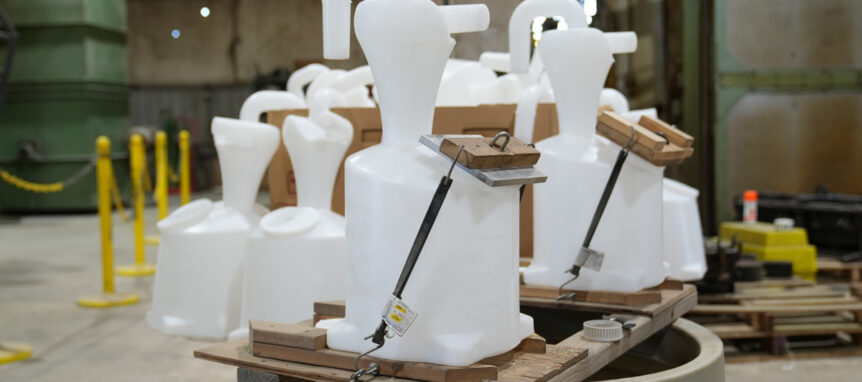When designing a plastic product using rotational molding, wall thickness may not be the first thing that comes to mind—but it should be. While often overlooked, wall thickness plays a critical role in determining the strength, durability, weight, and functionality of a molded part. Whether you’re producing an industrial component, a storage container, or a consumer product, understanding how wall thickness works in rotomolding will help you make smarter decisions that affect cost, performance, and quality.
What Is Wall Thickness in Rotational Molding?
Wall thickness refers to the distance between the inner and outer surfaces of a molded plastic part. In rotational molding, the thickness is determined by the amount of resin placed into the mold and how evenly it distributes during the heating and rotation process. Unlike injection molding, which uses pressure to force material into a cavity, rotational molding relies on gravity and slow, bi-axial rotation to coat the inside of the mold. This means there is more variability—and more opportunity for optimization—when it comes to wall thickness.
The standard wall thickness in rotomolded parts typically ranges from 0.125 inches to 0.375 inches, though this can vary depending on the application, material used, and design of the part. Uniformity is key: inconsistencies in thickness can lead to weak spots, structural issues, or material waste.
Why Wall Thickness Matters
Wall thickness isn’t just a number—it directly impacts how your part performs in the real world. A thicker wall generally means added strength and rigidity, which is ideal for parts exposed to impact, pressure, or environmental stress. On the other hand, thinner walls may reduce weight and cost but can compromise structural integrity if not properly supported.
Getting the wall thickness right ensures the part can handle its intended use without overengineering it. Overly thick walls not only increase material costs but also extend cooling times and can result in warping or uneven surfaces. Too thin, and the part may become brittle, prone to cracks, or unable to support weight or pressure loads.
In industries such as automotive, agriculture, and construction, where parts are often exposed to harsh conditions, optimizing wall thickness is crucial to achieving long-term reliability. In consumer products, achieving the right balance of thickness and aesthetics can affect both performance and user satisfaction.
Design Considerations for Consistent Thickness
To maintain even wall thickness, the design of the mold and part geometry must be carefully considered. Sharp corners, deep recesses, and abrupt changes in shape can lead to uneven material flow, resulting in thick or thin areas. Designers often use gradual transitions, rounded edges, and symmetrical features to encourage uniform coverage.
Part orientation within the mold also affects how material distributes during rotation. Proper rotation speed, oven temperature, and cooling control all contribute to consistent wall formation. Working with an experienced rotomolding team helps ensure that the final product meets performance expectations without material waste or unnecessary complications.
Consistency in thickness also allows for predictable behavior during secondary processes like trimming, drilling, or surface finishing. When the walls are even, post-molding operations become smoother and more reliable.
Material and Cost Efficiency
Wall thickness doesn’t just affect performance—it impacts your bottom line. Thicker parts require more material, which increases cost. They also take longer to heat and cool, which adds production time. Finding the ideal balance between strength and material use allows you to create high-quality parts while keeping costs in check.
Rotational molding is already known for its cost-effective tooling and low waste rates, but that efficiency can be amplified when wall thickness is carefully planned. Designers who prioritize thickness early in the development process are more likely to end up with durable, scalable, and budget-friendly products.
How Shiloh Custom Molding Optimizes Wall Thickness
At Shiloh Custom Molding, we take wall thickness seriously. From the first conversation, we work with clients to review part designs and recommend strategies that support uniformity, performance, and cost-efficiency. With over 15 years of combined experience, we understand the variables that affect thickness—from material selection to mold rotation—and we apply that knowledge to every project we take on.
Our team ensures every part we produce has the strength, durability, and visual appeal needed for its application. We also offer surface finishing services to refine texture and drop ship fulfillment to deliver completed parts directly to your customers.
Get It Right from the Start
Understanding wall thickness in rotational molding is essential to getting your product right the first time. It’s not just a technical detail—it’s a design choice that affects quality, longevity, and production efficiency. Whether you’re developing a rugged industrial part or a sleek consumer item, knowing how to balance thickness, material use, and structural needs will set your product up for success.
Have questions about your design?
Email info@shilohcustom.com to learn how we can help you optimize wall thickness and build your product with precision.

